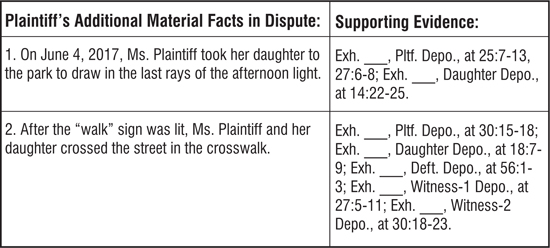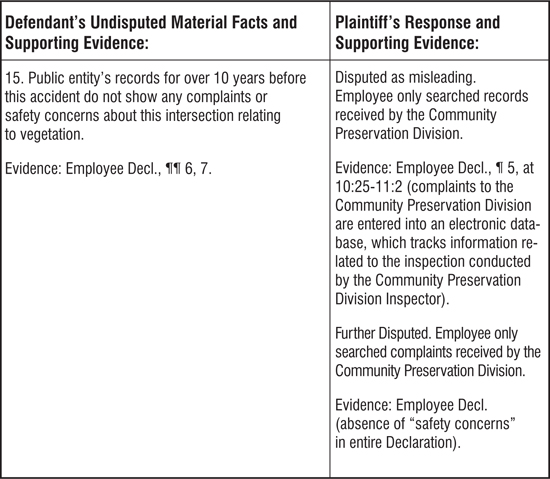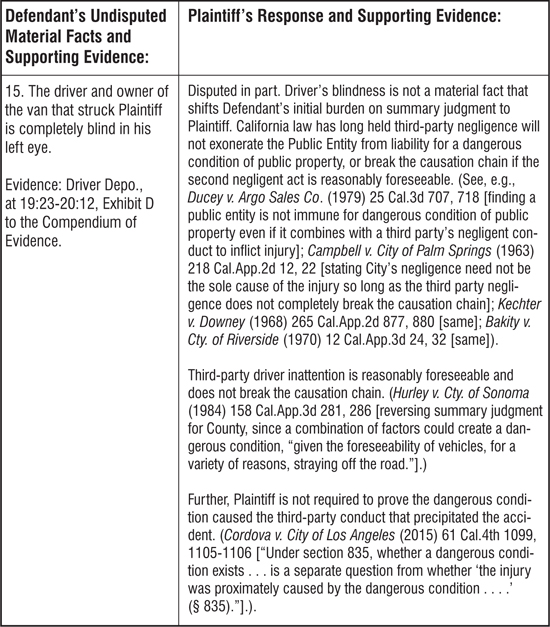Mastering the separate statement
This is the keystone in your memorandum opposing summary judgment
A summary judgment opposition is like a piece of music. “Plaintiff’s Memorandum in Opposition to Defendant’s Motion for Summary Judgment or Summary Adjudication or Both” (Cal. Rules of Court, rule 3.13350(e)(1)) is the melody. The story and arguments in the Memorandum must be compelling and memorable – it should get stuck in your head. The Declaration (and Request for Judicial Notice, if necessary), is the “bass line”; it literally lays the foundation for the court to consider the evidence in opposition. The various pieces of Evidence in Opposition come together in harmony to support the story.
The master score is “Plaintiff’s Separate Statement in Opposition to Defendant’s Motion for Summary Judgment or Summary Adjudication or Both” (Cal. Rules of Court, rule 3.13350(e)(2).) The Separate Statement is where the opposition documents intersect: the stand-alone document where everything comes together so the judge can easily see where the disputed issues lie.
Mastering the Separate Statement requires hard work, tremendous organization, and extreme attention to detail. But a powerful Separate Statement will make it easy for the court to deny summary judgment.
The separate statement is the keystone of the opposition
No document is more important in opposing summary judgment than the Separate Statement. The trial court has discretion to refuse to consider evidence not referenced in the Separate Statement. (San Diego Watercrafts, Inc. v. Wells Fargo Bank (2002) 102 Cal.App.4th 308, 315-316 [finding that since “whether to consider evidence not referenced in the moving party’s separate statement rests with the sound discretion of the trial court,” the so-called “Golden Rule” should be recast as a “baser metal.”].)
Following the legal rules for writing Separate Statements is vital to your credibility with the court. Start by (re-)reading Nazir v. United Airlines, Inc. (2009) 178 Cal.App.4th 243.) In Nazir, supra, the appellate court strongly admonished the defense for filing oppressive moving and reply papers. (Id., at p. 249, 251-253.) Do not fall into that trap by filing oppressive opposition papers! Also (re-)read Rule 3.1350 of the California Rules of Court, which instructs on titling and formatting the various documents.
Composing the separate statement
“Plaintiff’s Separate Statement in Opposition to Defendant’s Motion for Summary Judgment or Summary Adjudication or Both” has two parts. The first is the response to Defendant’s Separate Statement, where the plaintiff identifies whether the defendant’s allegedly undisputed material facts are in fact undisputed or disputed, with citations to evidentiary support for the dispute. The second component is Plaintiff’s Separate Statement of Additional Material Facts in Dispute.
You may want to start by attacking the defendant’s allegedly undisputed material facts: You walk into your office and see a huge pile of papers on your desk – the dreaded summary judgment motion. You read through the defendant’s Separate Statement, and it is garbage. Your mind races with all of the ways you will show the court how the defendant is flat-out wrong. Going into attack mode and showing how every one of the defendant’s allegedly material facts is bogus, misleading, not supported by the evidence, etc. is natural. Don’t give in to that urge – yet.
Draft Plaintiff’s Separate Statement of Additional Material Facts in Dispute first. Write a powerful story first, before trying to “Dispute” every fact in the defendant’s Separate Statement. Focusing on the “melody” will not only help coalesce your thoughts and force you to think through your legal arguments, but also will help you immensely in “disputing” the defendant’s allegedly undisputed material facts.
Making beautiful music – The art of drafting material facts
California Rules of Court, rule 3.1350, subd. (d)(2) and subd. (f)(3) emphasize, “The separate statement should include only material facts and not any facts that are not pertinent to the disposition of the motion.” Rule 3.1350, subd. (a)(2) of the California Rules of Court defines “material facts” as “facts that relate to the cause of action, claim for damages, issue of duty, or affirmative defense that is the subject of the motion and that could make a difference in the disposition of the motion.”
The art of writing “material” facts requires a thorough understanding of the law as it applies to your case. Knowing the elements of a cause of action is not enough. Thus, you must know: (1) the facts of the cases you will rely on; (2) the facts of the cases the defense relies on; and (3) how you will distinguish the defendant’s authority or otherwise argue it is inapplicable. Only then can you understand what makes a fact in your case “material.”
Depending on the issues in your case, a “material fact” may be a general statement. For example, in a dangerous condition of public property case where overgrown vegetation blocked the defendant driver’s view of a pedestrian, a material fact might be as simple as, “Ms. Plaintiff was crossing within the crosswalk.”
But perhaps you want to distinguish a case the defendant relies on or align the facts of your case with those of a great published opinion. In that instance, spell out the material facts in greater detail. Instead of, “The vegetation at the intersection was overgrown,” the material facts may be:
“The juniper is a relatively slow-growing shrub whose growth is more horizontally-oriented than vertically.”
“As of the date of the incident, the juniper hedge at the intersection was between four and five feet tall in violation of the Municipal Code.”
“To reach that height, the juniper bush would have to have been growing at that location for thirty to forty years.”
No matter how detailed your material facts are, keep it simple. Write the plaintiff’s additional material facts in a straightforward, simple way. By definition, “material facts” are “facts,” not “argument.” Save the arguments for the Memorandum. The court will appreciate the clarity. Make music, not noise.
The mechanics of drafting plaintiff’s separate statement in opposition
Although requesting an electronic version of the defendant’s Separate Statement is one of the first steps you should take when you receive an MSJ (Cal. Rules of Court, rule 3.1350(i)), physically typing the facts and evidence into the table cells is a process I reserve until near the end (and usually I don’t do it myself – more on that below). I write my story in a new, blank document, called PMFs_Master.
Continuing with the example of a dangerous condition of public property case, the material facts in my Master document might look like:
On June 4, 2017, Ms. Plaintiff took her daughter to the park to draw in the last rays of the afternoon light. (PMF ___.) Exh. ___, Pltf. Depo., at 25:7-13, 27:6-8; Exh. ___, Daughter Depo., at 14:22-25.
After the “walk” sign was lit, Ms. Plaintiff and her daughter crossed the street in the crosswalk. (PMF ___.) Exh. ___, Pltf. Depo., at 30:15-18; Exh. ___, Daughter Depo., at 18:7-9; Exh. ___, Deft. Depo., at 56:1-3; Exh. ___, Witness-1 Depo., at 27:5-11; Exh. ___, Witness-2 Depo., at 30:18-23.
Writing the Plaintiff’s Additional Material Facts in Dispute in numbered paragraph form is useful in several ways. First, I can easily tell where I am missing citations to evidence. I try to write my Additional Material Facts in Dispute with as many citations to deposition testimony or other evidence as possible. If six people agree, “The vegetation at the intersection was present for many years” (or “the light was green,” or “the plaintiff was crossing in the crosswalk,” etc.), I want the court to see a long list of citations behind my single material fact. A long list of citations is not always possible – and obviously do not stretch the evidence to increase the list of citations – but build credibility with the court by showing how well you know the evidence in support of the material facts.
In addition, I separately number the paragraphs using an automatic numbering feature (Microsoft Word or WordPerfect). Each PMF will eventually correspond to the paragraph number. If I change the order of or consolidate the material facts, the paragraph numbers automatically update. When the additional material facts are finally finished, replacing the blanks in the PMF is simple: just add in the existing paragraph number.
Once your Declaration is drafted and other foundational evidence identified, you can use the Find + Replace feature to properly identify the Exhibit number. You must write the same text each time (e.g., Exh. ___, Pltf. Depo), and copy/paste exactly for this method to work [Find Exh. ___, Pltf. Depo; Replace with Exh. 1, Pltf. Depo]. That way, the software will input all the exhibit numbers for you automatically, and you do not have to worry about typos.
This method also makes copying/ pasting the material facts into the Plaintiff’s Memorandum and table easy. With the Master document finalized, I leave these next steps to my legal assistant. To insert the additional material facts into your Memorandum, create a copy of the finalized PMFs_Master document and name the new document PMFs_PsAs (or whatever you like).
Creating a copy of the Master document ensures you always have that version to refer to in case your computer crashes – essentially, anticipating Murphy’s Law. Remove the automatic numbering feature and delete the citations to evidence only, leaving the PMF citation intact, then copy/paste the material facts and PMF citation into your Memorandum, cleaning up the paragraph breaks or other formatting issues. (You can always consolidate the facts further in the Memorandum if needed.)
To insert the additional material facts into your Separate Statement, create a copy of the finalized PMFs_Master document and name the new document PMFs_Sep_Stmt. Copy/paste the text into your table (Microsoft Word can automatically number the cells in your table, so you don’t have to worry about skipping numbers). (See Figure 1.)
Plaintiff’s Separate Statement of Additional Material Facts in Dispute
Plaintiff’s Separate Statement of Additional Material Facts in Dispute should follow the last issue in the defendant’s Separate Statement. Do not risk the additional material facts getting separated from the rest of the papers. Keep the additional material facts in the Plaintiff’s Separate Statement in Opposition.
Note that I do not follow the format in California Rules of Court, rule 3.1350(h) for Plaintiff’s Separate Statement of Additional Material Facts in Dispute. The Rules of Court do not specify a format for the opposing party’s additional material facts. Further, Nazir is clear that the defendant does not get a “Reply Separate Statement.” (Nazir, supra, 178 Cal.App.4th at pp. 249, 252.). Do not invite the defense to ask for a Reply Separate Statement by creating a column for “Opposing Party’s Response and Supporting Evidence.” The defense may argue a response to Plaintiff’s additional disputed material facts is proper. (Nazir, supra, 178 Cal.App.4th at p. 249.) True – but neither the California Rules of Court nor Nazir specifies the format of the response.
Moreover, I never understood why the defendant would want to respond in Separate Statement format. Defeating summary judgment requires merely a single disputed issue of material fact. (Code Civ. Proc., § 437c, subd. (c) [“The motion for summary judgment shall be granted if all the papers submitted show that there is no triable issue as to any material fact . . . .” (emphasis added)]; Code Civ. Proc., § 437c, subd. (g) [“Upon the denial of a motion for summary judgment on the ground that there is a triable issue as to one or more material facts, the court shall, by written or oral order, specify one or more material facts raised by the motion that the court has determined there exists a triable controversy.” (emphasis added)].)
Logically, then, either: (1) the defendant does not dispute any of the plaintiff’s additional material facts (to take all of the disputed facts out of dispute, and thus make them undisputed); or (2) every single one of plaintiff’s additional material facts are unsupported by the evidence (so there are no additional material facts in dispute for lack of evidentiary support – which is why laying the proper foundation for the evidence is crucial!). Neither of these options requires a response in Separate Statement format; meaning that argument in the Reply Memorandum or by way of Defendant’s Objections to Plaintiff’s Evidence should suffice.
If the defendant requests an electronic version of Plaintiff’s Separate Statement of Additional Material Facts in Dispute, I send the document but politely point out: (1) a Reply Separate Statement is not authorized under the Code (Nazir v. United Airlines, Inc. (2009) 178 Cal.App.4th 243, 249, 525); and (2) filing a response to Plaintiff’s Additional Material Facts in Dispute will only demonstrate to the court the abundance of disputed material facts. With so many material facts in dispute, the court cannot grant summary judgment.
Responding to defendant’s separate statement of allegedly undisputed material facts
Again, my overarching, non-legal (but completely practical) rule is to keep it simple. Be clear and concise. Concede facts when possible. If only part of a material fact is in dispute, admit the undisputed portion. Do not overcomplicate an issue. Earn credibility points by focusing the court’s attention on the material facts truly in dispute. Remember, you can lose a couple of battles (i.e., agree certain facts are “undisputed”) and still win the war. Use the court’s time wisely – do not force the court to research and review ultimately undisputed evidence.
That said, read the defendant’s cited evidence in support carefully. Often the defendant will “argue” the evidence; i.e., the evidence relied on does not entirely support the proposition asserted.
Defendant’s undisputed material facts and supporting evidence: Plaintiff’s response and supporting evidence
If you are disputing one of the defendant’s material facts with one of Plaintiff’s Additional Material Facts, the benefit of completing the Plaintiff’s Additional Material Facts first is clear: you can copy/paste the additional material fact and all supporting evidence without worrying whether you forgot to include some evidence, or modified the material fact in some way. Do not just direct the court to the PMF number. Copy/paste the entire additional material fact and supporting evidence into the disputed cell, then cite to the particular PMF. (See Figure 2.)
When disputing a material fact for lack of evidentiary support, you must identify the objection number in the Response column. It can read something like, “Disputed. No admissible evidence in support. See Plaintiff’s Objection No. ___.” (Although beyond the scope of this article, make objections to evidence sparingly. The court will take your handful of objections more seriously than if you make dozens of objections for the sake of objecting. Provide case-specific citations whenever possible – the court will be much more inclined to sustain your objection when you provide the court with solid legal grounds to exclude the evidence.)
Further, use the space afforded by a Separate Statement to your advantage – without violating Nazir. Unlike the Memorandum in Opposition, the Separate Statement in Opposition has no inherent page-limit. If an allegedly material fact is not material as a matter of law, I point out why according to the case law. By citing the authorities that demonstrate why a so-called material fact is not actually material in the Separate Statement, I save precious real estate in the Memorandum in Opposition.
For example, in a dangerous condition of public property case, third-party negligence is irrelevant to determining whether the public entity is liable for the dangerous condition, so long as the third-party negligence was reasonably foreseeable. (See Figure 3.)
Defendant’s undisputed material facts and supporting evidence: Plaintiff’s response and supporting evidence
By placing the identifying authorities in the Separate Statement, you can save at least a paragraph’s worth of real estate in the Memorandum. Use this technique sparingly, however; only for the allegedly undisputed facts that really matter – remember, KISS. Keep the court’s attention focused on the truly disputed issues. Even if you could provide a full list of citations for why an allegedly undisputed material fact is immaterial, think about whether the fact harms your client’s case before copying/pasting in the authorities. If the material fact is harmless, don’t bother.
Finally, use the unlimited real estate in the Separate Statement to build credibility with the court. For example, when citing to documentary evidence, cite the document as well as the foundation for the document: “Exh. 19, Witness-1 Depo., at 29:25-31:5, 31:11-13, 32:1-4, see also, Exh. 6-1, at p. 2 [foundation for Exh. 6-1: Witness-1 Depo. (Exh. 19), at 29:18–30:7; Attorney Decl., ¶ 6, at 22:3-16]. The court will be impressed with the obvious thoroughness and preparedness.
Conclusion
The Separate Statement is the master score that brings together all of the hard work you put into the Opposition. The court should read the Separate Statement and know exactly what the disputed issues are – and why the motion must be denied. A masterpiece Separate Statement will be music to the court’s ears.
Alyssa Kim Schabloski

Alyssa Kim Schabloski is a trial attorney with Gladius Law, APC. A plaintiff’s lawyer for her entire legal career, she practices in employment law, medical malpractice, and catastrophic personal injury. Alyssa graduated from Barnard College and obtained her JD and MPH from the UCLA Schools of Law and Public Health. She served as 2020 President of the Los Angeles Trial Lawyers’ Charities (LATLC) and President of the Cowboy Lawyers Association from 2019-2021. She is a member of the CAALA Board of Governors. Alyssa is admitted to practice in California, Arizona, and New York.
Copyright ©
2025
by the author.
For reprint permission, contact the publisher: Advocate Magazine



